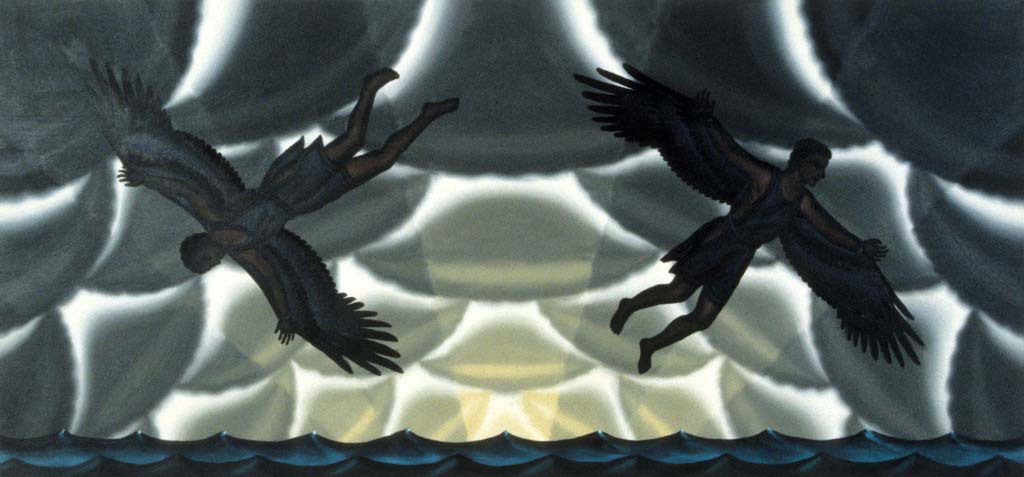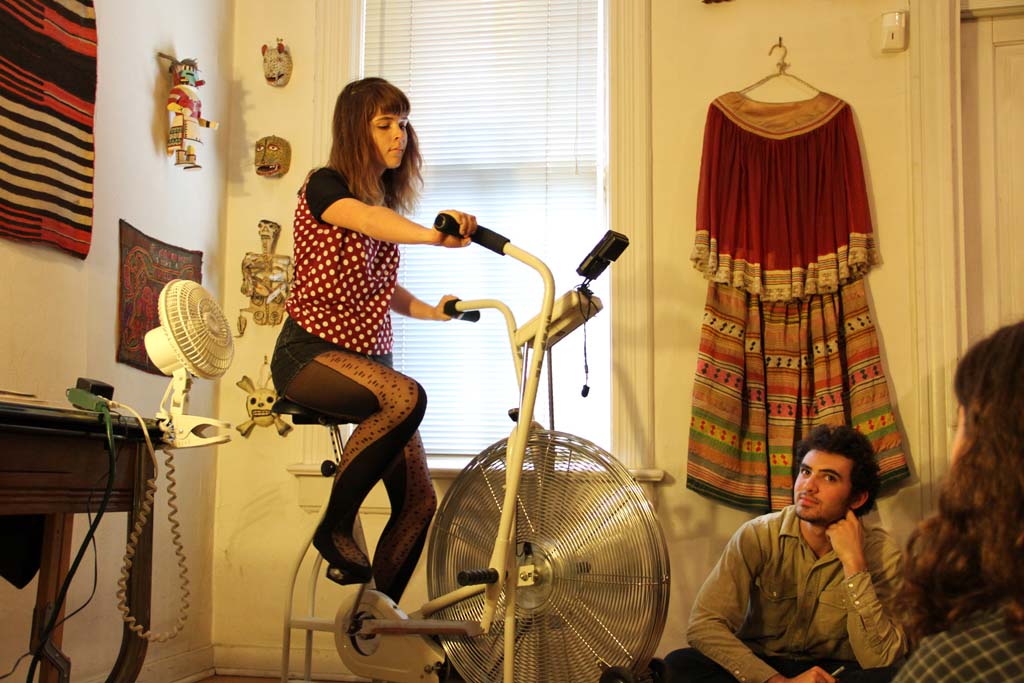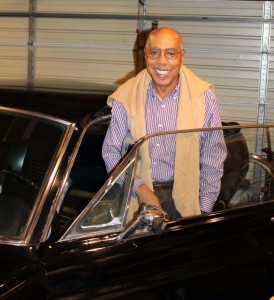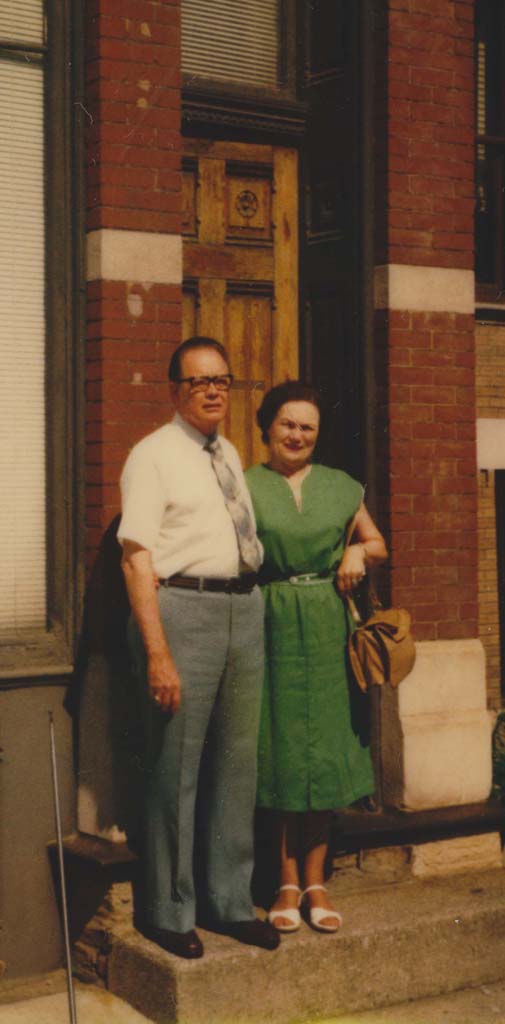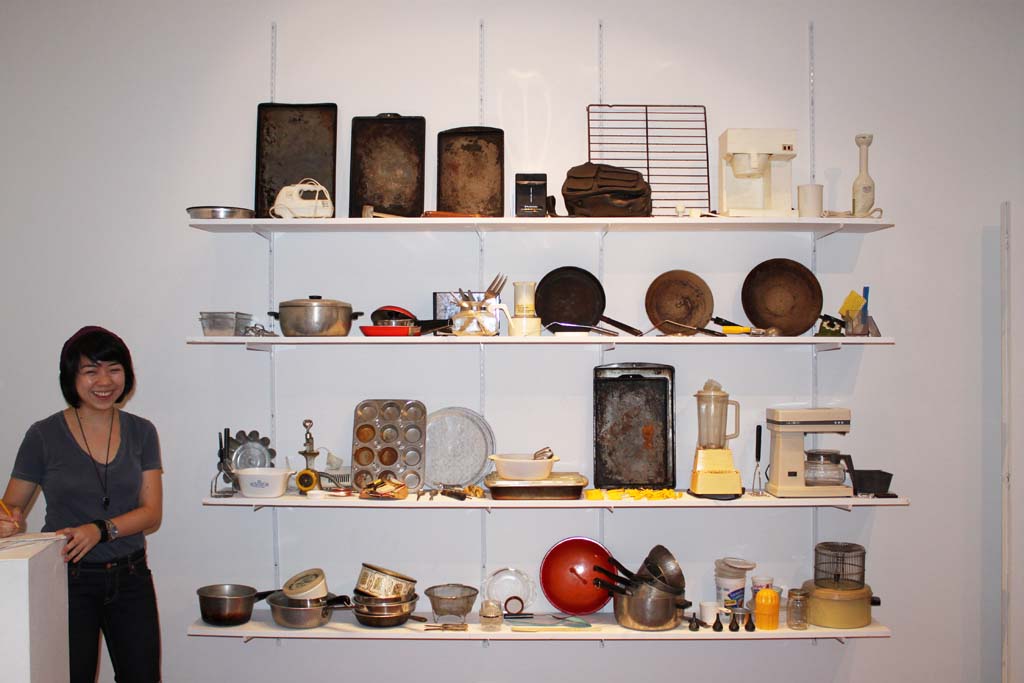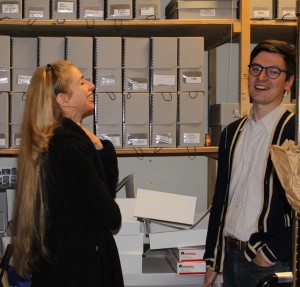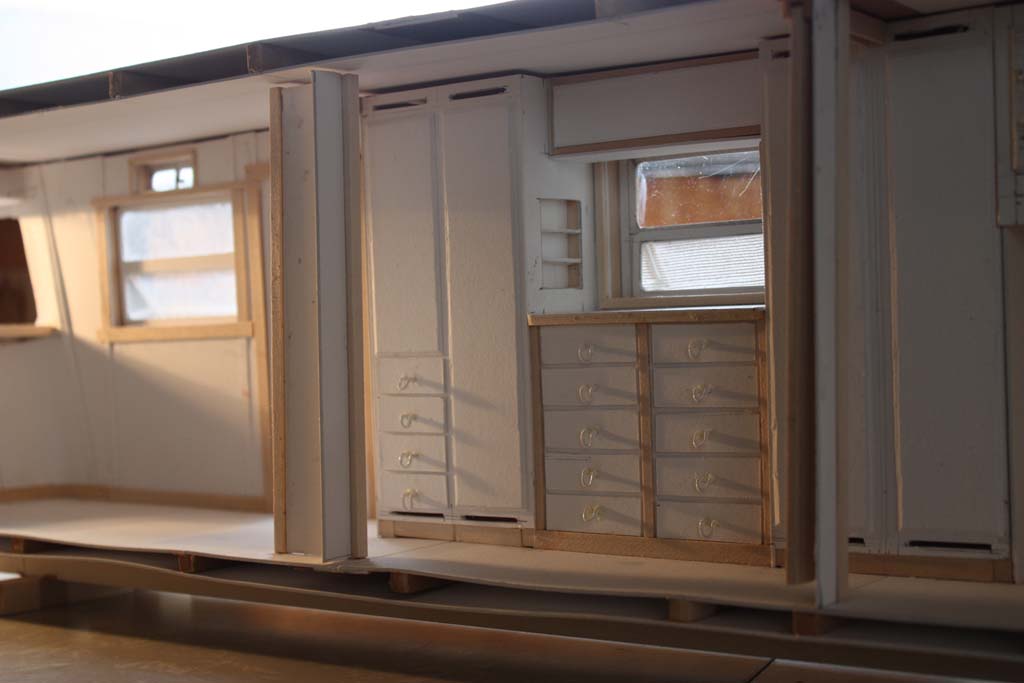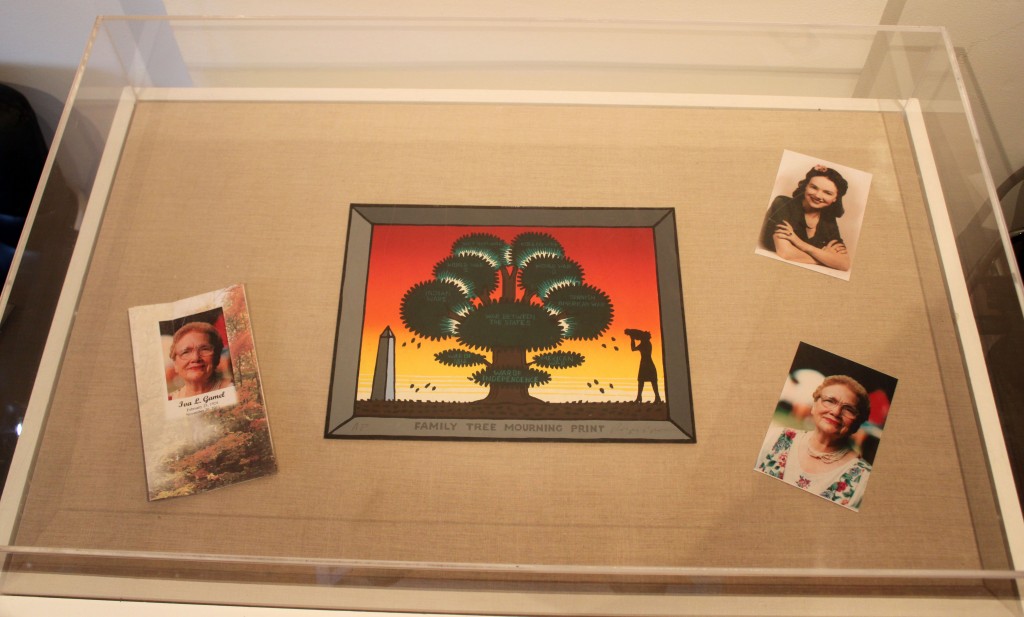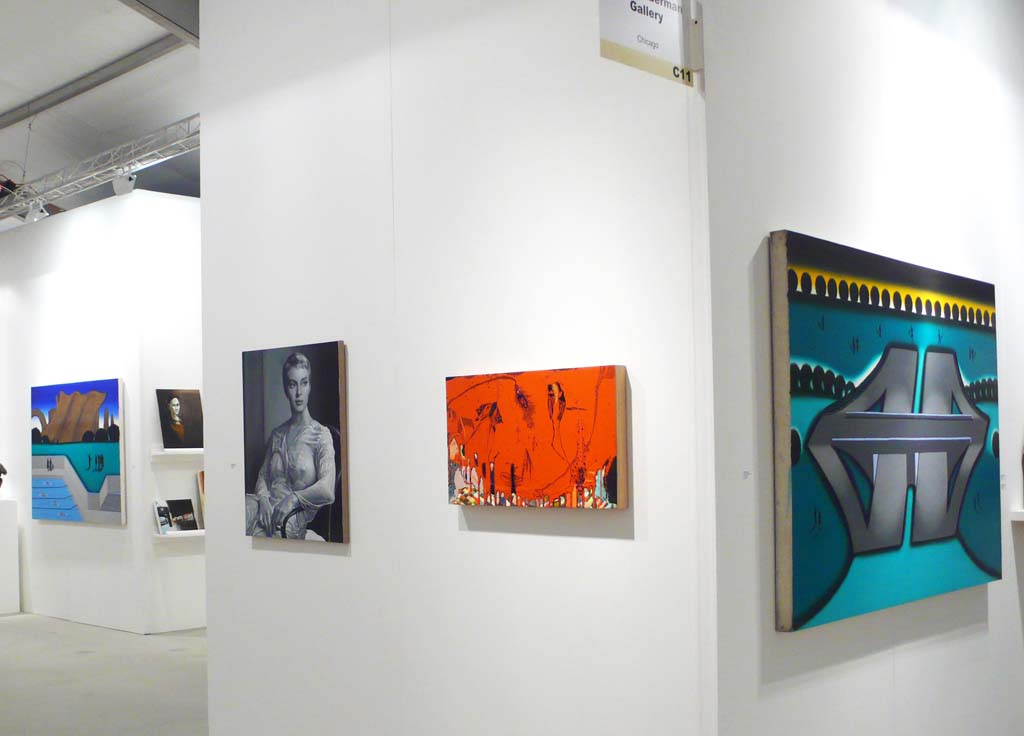Roger Brown Study Collection fall update
Monday, December 19th, 2011 » By lstone » See more posts from ALL THE NEWS
Just Add Water….
In July heavy rain flooded the basement at 1926. Among the hidden treasures we exhumed during the cleanup were eight carved and silver-painted panels of draped fabric with billowing folds. In a 1995 video they appear installed in Brown’s studio and he explains that these lovely, enigmatic objects were panels from a hearse, found at a yard sale outside of Chicago. They may have been from a horse drawn hearse or a horseless carriage–we’re still researching the history of these wonderful examples of the persistence of the Victorian mourning tradition past Victorian times. They’re on view in our display entitled Drapery & Death. Opposite the panels, we hung Brown’s somber study of Daedalus and Icarus flying against a luminous, billowing cloudscape.
We spend much time considering the objects in Brown’s collection and it was exciting to discover the objects he chose to hang in his studio. The panels, muses perhaps, reflect Brown’s aesthetic sensibility, recalling the theatre drapery from his early works, the many slides of draped fabric from his travels, and the signature clouds that form the visual and conceptual backdrop for so many paintings.
Classes, guests
Fall semester was packed with 60 SAIC classes and many other guests, with over 2200 visitors this year, a major uptick from 2010. Exciting uses of the collection included:
Mark Jeffery’s Performing the Document class addressing the building and collections as one grand archival document, evidence of a creative life lived, thought, and responded to. They explored the site and created and performed works in the basement, throughout the collection, in the gallery, bathroom, garage, and out in the alley, bringing the site and it’s histories to life in fresh, imaginative, and deeply thoughtful ways.
We hosted several departmental retreats, including Walter Massey’s President’s Cabinet, endearing many key administrators to 1926 as an inspiring place for administrative gatherings.
Intuit hosted a bike tour of unusual sites around Chicago; approximately 50 intrepid cyclists parked their bikes in the ally, gathered in the garden and downed gallons of apple cider and (in smaller groups) toured the collection.
Preserving 1926
The summer flood was a calamity turned blessing in disguise. A crew completely emptied, cleaned, and sanitized the basement and repaired the stairway. We discarded a small mountain of detritus that accumulated over the years, possibly since the century before last. The basement was transformed from a dismal crypt into a clean space with epoxy-painted floor, new wire shelving, and expanded storage and workspace, all elevated high enough to weather any future storms. The project took several weeks, knocking other projects to the back burner, and instigated the reorganization of many materials and collections.
In August we received architect Tom Bassett-Dilley’s Code and Occupancy Study, commissioned last spring. The study outlines necessary modifications to the building organized into two phases. Instructional Resources and Facilities Management (IRFM) retained Bassett-Dilley (assisted by Von Dreele-Freerksen Construction Co.) to do a scope-of-work outline for all the recommendations. Working with IRFM staff, the facilities renewal was updated to 2017 and includes maintenance and upgrades to many elements and systems.
The door to the north stairway is being restored by Neal Vogel/Restoric to its 1995 appearance–largely the original 1888 design. The door will be much stronger, weather-tight, and more impervious to the elements. We recently found this photo of Roger’s parents at the north door, giving us much needed archival documentation for the finish.
Restoric prepared and coated the cast iron entry porch and threshold, a seemingly minor but significant improvement. The cast iron was corroding badly, as the porch tilts downward allowing rain water and snow to collect and dwell.
The storefront entry doors are perhaps the most used and abused elements of the building. These drafty doors have deteriorated over the years. Just in time for the winter solstice, Restoric removed the doors to undertake a complete restoration. This major project is funded by a generous grant from the Walter and Karla Goldschmidt Foundation.
Archive, collections
The flood set a number of organizational projects into motion. The contents from Brown’s kitchen cabinets had been stored in the basement for years. We unpacked, cleaned, and photographed, and carefully documented 169 objects, honing our abilities to describe housewares along the way, before repatriating the objects to their rightful place in the kitchen.
Adventures in archiving…
Leslie Buchbinder, director of Pentimenti Productions, continues work with her team on research and production of a major documentary video on Chicago Imagist art. We’re providing Pentimenti Productions in-depth access to the RBSC Archive to support this wonderfully stimulating and mutually beneficial project. Leslie added James to the Pentimenti team, and in this role he’s scanning scads of images and documents, including a large measure from the RBSC archive, according to preservation standards. Pentimenti generously covered the cost of transferring Roger’s Super-8 home movies to dvd, among other contributions to the RBSC archive. This and the ongoing scanning project continues to advance the organization of our archive and our understanding of our holdings, greatly. Working with the Pentimenti team continues to be a true adventure in mining archival materials for the golden nuggets they contain. Watch this space for more information on Pentimenti’s forthcoming video production.
La Conchita collection
La Conchita collection curator Nick Lowe is spending his year-long sabbatical delving deeply into Roger Brown’s homes, gardens, collections, and artworks, both real and imagined. Over the summer he worked on the La Conchita inventory, updating and refining the database with works not examined or used in the Calif. U.S.A project. In September Nick and assistant curator James Connolly travelled to the Roger Brown Rock House Museum (Beulah, Alabama), where they scanned many archival materials, including photos, letters, writings, and ephemera. He then spent two weeks in Roger’s Spartan trailer at the Museum of Jurassic Technology, fine tuning the documentation of the La Conchita garden, planning a partial re-creation of the garden around the trailer, and creating a scale model of the trailer, adding to his ongoing creation of scale models of the La Conchita home and garden. Nick spent two weeks in October at the New Buffalo site, where he began constructing a scale model of Roger’s architectural drawings for an unrealized adobe house and compound in Lompoc, CA. Nick’s intensely focused research lends ongoing, high-level inspiration to our work at the RBSC and New Buffalo. Please peruse Nick’s project blog for more information about this incredible, ongoing project.
Volunteers
Enthusiastic thanks to Justin Bergquist, Dana Boutin, Laura Fox, Leland Meiners, Thea Nichols, Dahlia Tullett, Bob Wimp, and Jamie Young for assisting with public tours and receptions. We’re sorry to have lost Laura Fox as an RBSC volunteer but we wish her the very best at her new job as public relations manager for three state museums in Doha.
Roger Brown / New Buffalo, Michigan site
This spring ongoing maintenance of the New Buffalo site addressed sanding and refinishing the floors and repairing and painting the walls in the River Pavilion. In mid May, James, Nick, and I worked with Tim Fox and his crew to de-install the entire collection of art and furniture and move it to the Studio and Guest House. In the process we cleaned and photographed each object and created new inventory records. In early June we reinstalled the collection in the newly refurbished house. We created a detailed de-installation/re-installation manual for future projects. A new security system was installed and the dining room chairs were reupholstered. (See the previous blog post for more on this project.) Working with Historic Preservation program faculty member Carol Yetken, CYLA, we’re moving forward on the restoration of the historic landscape at the New Buffalo site in spring 2012.
Brown / Palmer family
We join the Brown family in mourning the passing of Aunt Iva Gamel, Roger and Greg’s (and our) beloved aunt. Iva’s daughter Trudy established a memorial in Iva’s name, benefiting the Roger Brown Study Collection. We look forward to celebrating Iva’s life and remembering her here at the RBSC.
Roger Brown Estate
Russell Bowman, Russell Bowman Art Advisory, continues his representation of the Roger Brown Estate for SAIC, placing works in private and public collections and arranging exhibitions. Bowman placed Brown’s iconic painting, Dr. Imperial’s Tree of Knowledge (1985, oil on canvas, neon, 106 x 73 x 3 1/2”), which had hung in Brown’s La Conchita, California home, in the collection of the Montgomery Museum of Fine Art. Bowman is working with DC Moore Gallery in New York and Zolla Lieberman Gallery in Chicago on exhibitions of Brown’s work in 2012 and 2013. Zolla Lieberman Gallery included works by Brown in their booth at Art Miami in December.


